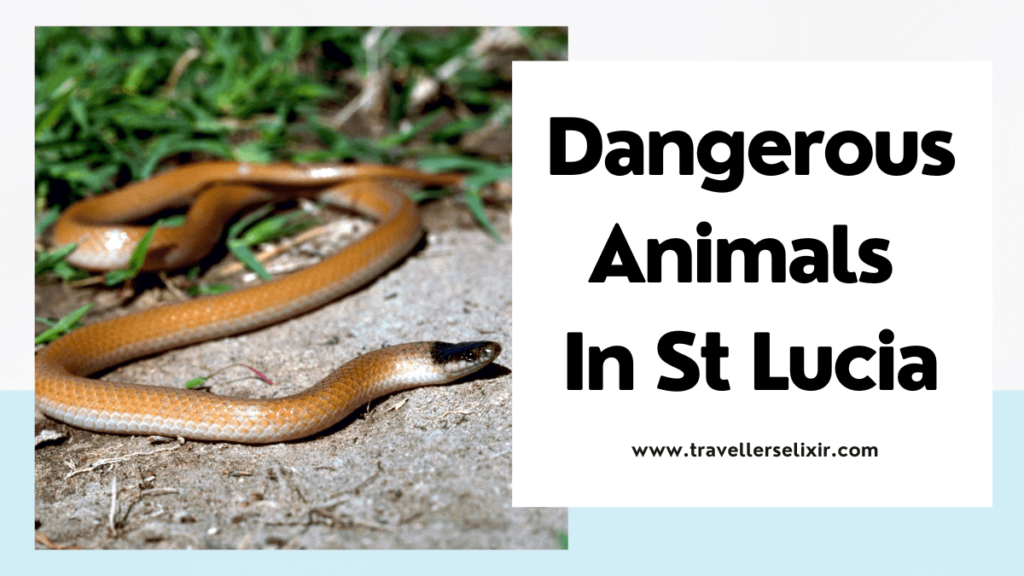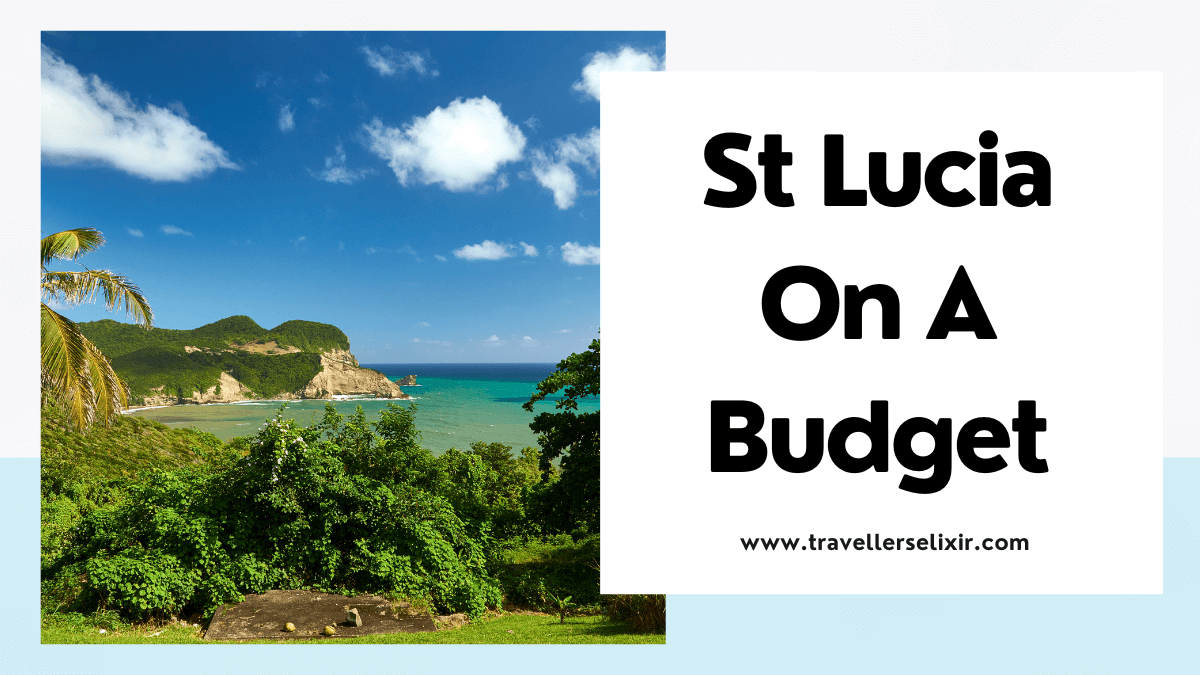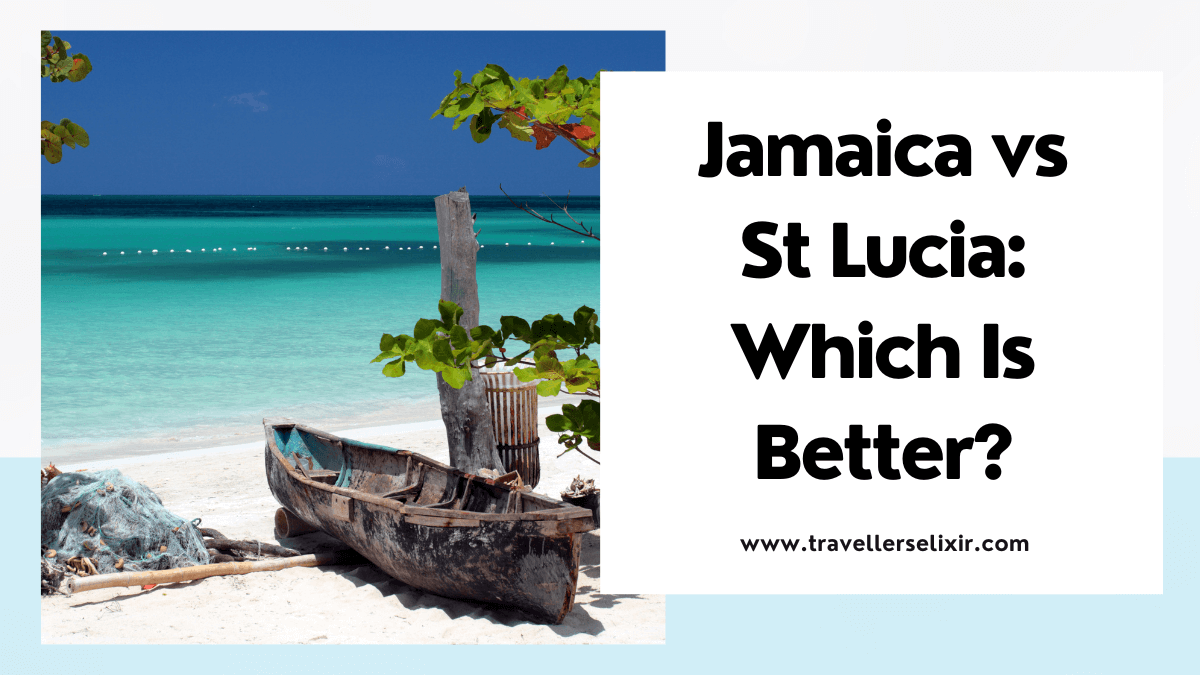If you’re visiting St Lucia soon then you might be wondering if there are any dangerous animals in St Lucia that you need to watch out for.
I was exactly the same! I spent hours researching this topic before I visited and now that I’ve been to the island myself, I thought I’d put together this handy guide.
This post is super honest as I’ll give you all the facts on St Lucia’s dangerous animals without underplaying the risk they pose.
Are There Dangerous Animals in St Lucia?
There are some dangerous animals on the island including snakes, mosquitos and jellyfish.
I’ll give you the full lowdown on each one shortly but the first thing that I want to say is that, as a tourist, you have very little to worry about and the presence of these animals shouldn’t put you off from visiting.
There is actually a huge list of animals that live in St Lucia including a range of birds, mongoose, lizards, frogs, whales, seals, snakes, turtles and more.
Most of the animals in St Lucia are harmless and don’t pose any sort of threat to humans but some do.
Some animals in St Lucia could hurt you. Injuries can include painful stings or bites, diseases and, in extreme circumstances, hospitalizations.
There is even one type of snake in St Lucia that has the potential to cause death to humans (extremely rare).
Below I’ve covered all of the dangerous animals in St Lucia including how you can protect yourself.
Crocodiles
There are no crocodiles at all in St Lucia in the Caribbean.
I thought I’d include this one as when I first told one of my friends I was going to St Lucia she worriedly told me the place was overrun with crocs.
I’ve no idea where she got this from but apparently it’s a common worry. Luckily, after doing a bit of research, I found out that it’s a misconception.
Google seems to get very confused when you type in this question as there is a small town called ‘St Lucia’ in South Africa which does have a large population of crocodiles.
St Lucia, the Caribbean island, however doesn’t have any crocodiles or alligators.
Snakes
St Lucia has four different types of snakes however only one of them is dangerous to humans.
Snakes are rare in St Lucia and aren’t really found anywhere near the main resort areas like Rodney Bay, Castries, Soufriere or Gros Islet.
They tend to live deep in the rainforest, far away from humans.
The fer-de-lance snake, which is found in St Lucia, is one of the deadliest snakes in the world. Its bite has the ability to fatally wound you if left untreated.

It’s worth noting that death from this snake bite is extremely rare and will only really occur if you don’t seek medical attention.
According to the Caribbean Doctors Association, between 2007 and 2018 there were 104 reported snake bites in St Lucia and only 3 deaths.
This snake is limited to two small sections of the island which aren’t major tourist hotspots so it’s unlikely you’ll ever spot one.
I spent a week in St Lucia and didn’t see a single snake. I even went hiking in the rainforest and still didn’t see one.
As long as you don’t go off wandering alone into St Lucia’s wilderness then it’s unlikely that you’ll come into contact with one.
Boa constrictors also do exist in St Lucia but they aren’t poisonous and can’t really hurt humans.
They’re a bit scary though, especially if you come across a group of them piled on top of each other (which happens during breeding season).
Here’s a news report in St Lucia all about boa constrictors and what you should do if you see one:
For more information on St Lucia’s snakes (including a map of the fer-de-lance habitat) check out my guide on snakes in St Lucia.
Sharks
There are not normally sharks present in the waters surrounding St Lucia.
Whilst sharks have been known to show up in the Caribbean from time to time, they aren’t really an issue in St Lucia.
In fact, the bull shark (which is responsible for most shark attacks on humans) has never been spotted in the waters surrounding St Lucia at the time of writing.
Additionally, there have been no shark attacks on record in St Lucia which should put your mind at ease.
The only sharks that have ever been spotted in St Lucia are small reef sharks and nurse sharks.

These types of sharks are spotted occasionally by divers out at super deep depths and are not regularly seen close to the shore.
I did a lot of snorkeling in St Lucia and I spotted one small reef shark. I didn’t bother it and it didn’t bother me.
These types of sharks are harmless to humans and fairly small so even if you do come across one, you have nothing to worry about.
If you’re still worried then check out my complete guide on sharks in St Lucia which includes the full history and everything you should know.
Tarantulas
Tarantulas can be found in St Lucia in certain habitats however they are not dangerous to humans.
Tarantulas are probably one of the world’s scariest creatures (at least, I think so!), so it’s quite unsettling to know that they exist in St Lucia.
As someone who is absolutely terrified of spiders, I spent a lot of time researching how common spiders and tarantulas are in St Lucia and I’m pleased to report that they are not common at all.
Whilst you will see ‘house’ spiders around St Lucia, big spiders and tarantulas are rare.
Although tarantulas do live in St Lucia (it’s a tropical island after all), they tend to live in the jungle and rarely pop up to scare tourists.
I don’t want to scare you but I did see a tarantula when I visited.
I was hiking Gros Piton and my guide told me that tarantulas live inside the holes of some of the trees – he got me to look inside one and, lo and behold, there it was – a scary hairy tarantula leg!
It’s also worth knowing that tarantulas are harmless to humans. They do possess venom but it’s actually weaker than a bee’s so can’t harm you.
They do have the ability to bite you (which will hurt) but their bite isn’t particularly dangerous to humans.
Bites are ridiculously rare as the tarantalas in St Lucia are super skittish and they usually run away when they sense movement.
It’s best not to approach one just in case (I’m not sure why you would!). Also remember to not go looking inside holes in trees if you don’t want to see one.
To find out more about St Lucia spiders check out my complete guide.
Other Bugs
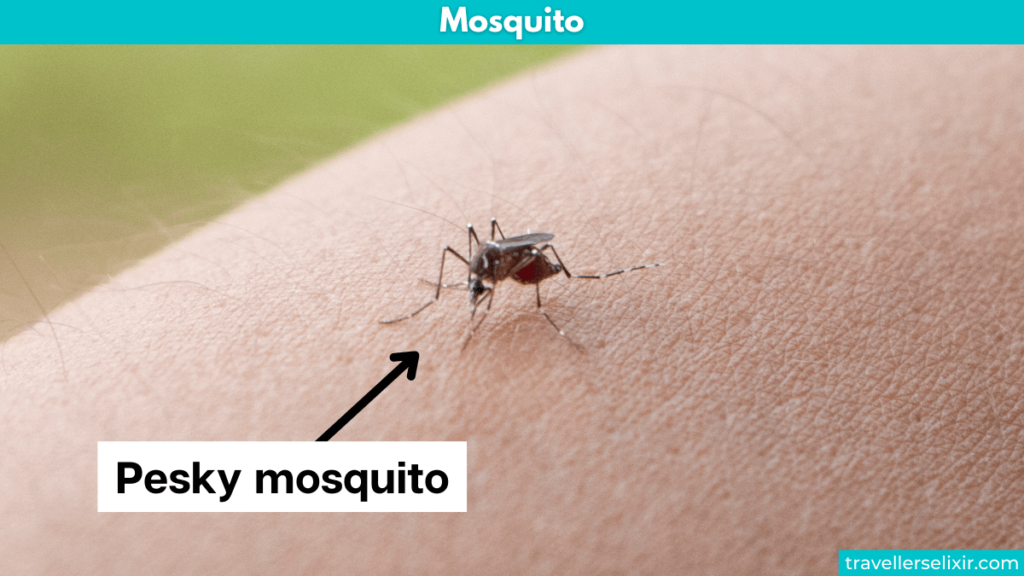
The main bug found in St Lucia that poses any type of risk to humans is the mosquito.
Unfortunately, mosquitos are rampant in St Lucia (especially during the rainy season) so insect repellent is a must.
Although the majority of bug bites in St Lucia will just cause an annoying itchy bump on your skin, there is a tiny risk that they could cause a mosquito-borne disease.
Thankfully, malaria isn’t present in St Lucia but other diseases are.
The main mosquito-borne diseases present in St Lucia are dengue fever, chikungunya virus and zika virus.
For this reason, it’s recommended that you wear mosquito repellent to prevent mosquito bites.
I personally have found that any mosquito repellent that contains at least 15% DEET prevents pretty much all bug bites.
I wore this one when I was in St Lucia and didn’t get any bites at all!
For more information on bugs in St Lucia read my complete guide which covers everything you need to know about mosquitos.
Jellyfish
Jellyfish are sometimes spotted in the waters surrounding St Lucia from time to time however jellyfish stings are rare.
There are various species of jellyfish present in St Lucia however you’ll be glad to know that none have the ability to fatally wound you.
Jellyfish stings are rare (but they do occur occasionally) and most are mild. For this reason, it’s safe to swim in St Lucia.
I swam in the ocean almost every single day of my trip and didn’t come across a single jellyfish.
For more information on St Lucia jellyfish, check out my complete guide which discusses the exact jellyfish species and what to look out for.
Scorpions
Scorpions can also be found in St Lucia however I didn’t personally see one myself.
Their stings are painful but not lethal and they won’t cause you any harm other than the painful sting itself.
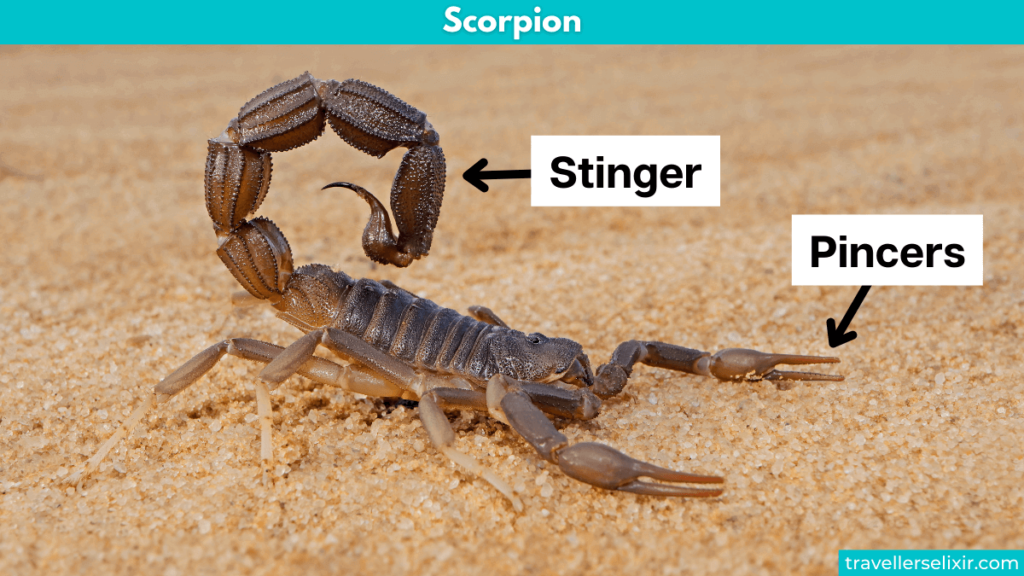
Scorpions are nocturnal so it’s unlikely that you’ll see one in the daytime. Watch out if you’re planning on going camping in St Lucia as reports of scorpions are high amongst campers.
You’ll tend to find them hiding under rocks so if you don’t want to see them, don’t look under any rocks!
As long as you don’t go prodding the scorpions, it’s unlikely that you’ll be stung and if you’re just sticking to the main tourist areas, you probably won’t see one anyway.
Sea Urchins
Sea urchins can sometimes be found on the seafloor near the shore on many of St Lucia’s beaches.
Sea urchins aren’t particularly harmful to humans but if you step on one, it will hurt. The best way to prevent this is to wear water shoes.
These spiky little creatures are easy to spot so when entering the water at the beach, have a quick look for them before moving forward.
I did see a few of these bad boys when I was swimming in the ocean. I carefully avoided them though and didn’t sustain any sea urchin-related injuries luckily.
If you do step on one then you need to be careful. Although not poisonous, their spikes can snap off and get lodged in your skin which is uncomfortable.
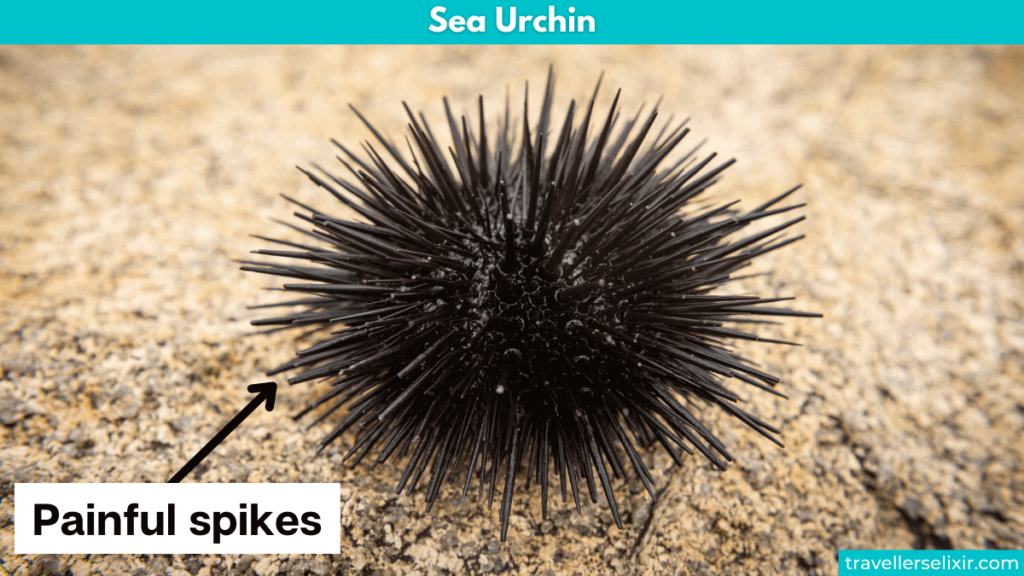
How To Avoid Dangerous Animals in St Lucia
By sticking to the main tourist areas, you’ll avoid the majority of St Lucia’s dangerous animals.
Remember that these types of animals, like snakes and spiders, are more scared of you than you are of them.
For this reason, they tend to live in quiet, rural areas away from humans so by avoiding these areas, you’ll avoid the animals.
Here are some key tips on how to avoid St Lucia dangerous animals:
- Don’t go trekking in the countryside alone. If you really want to do this, go with a tour guide as they will know which spots to avoid.
- Don’t approach a dangerous animal. Although it can be tempting to snap a photo to show your friends back home, it’s not worth the risk.
- Walk away slowly. If you run away, this might startle the animal and cause them to attack you.
- If you do get bitten by a snake, seek medical attention immediately. The deadly fer-de-lance snake bite can be treated successfully but only if you act fast.
And that’s it!
As I mentioned, I didn’t see the majority of these dangerous animals when on vacation in St Lucia so it’s likely you won’t see them either.
Did you know that St Lucia has monkeys? Well kinda, there’s not an established population and they are actually considered an invasive species due to the harm they have on agriculture.

